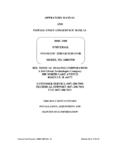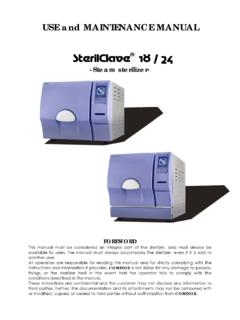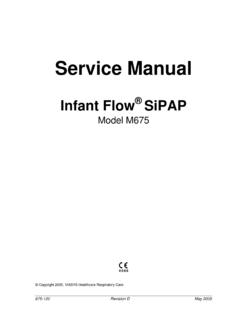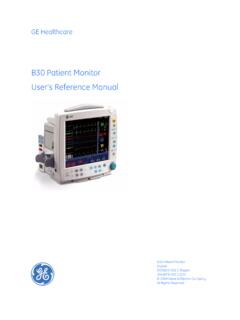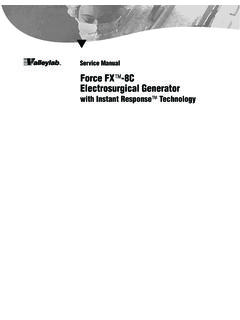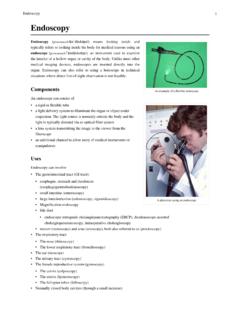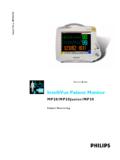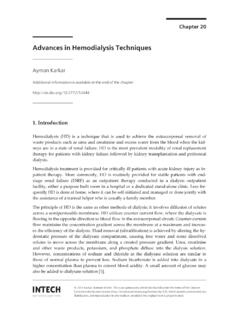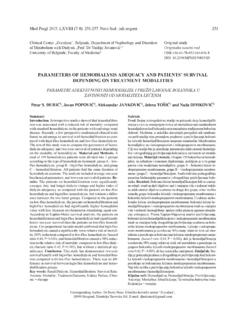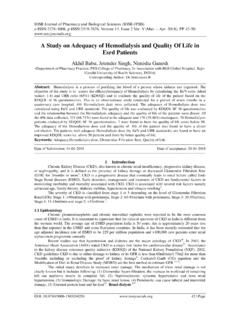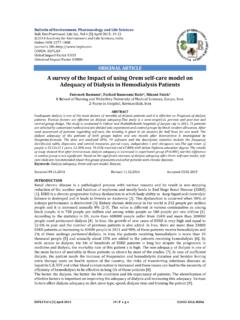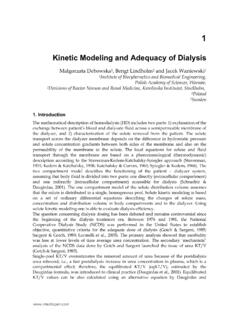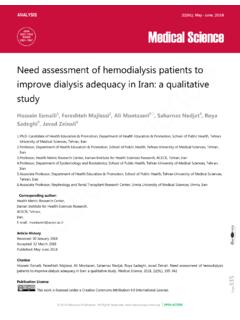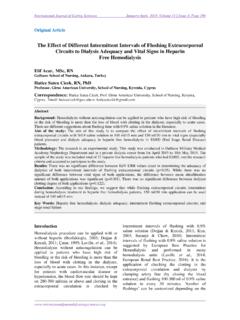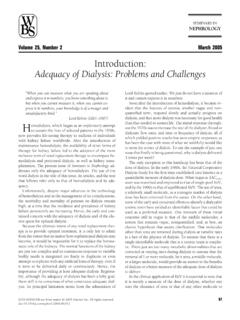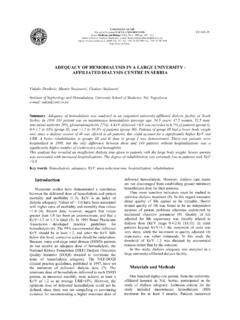Transcription of The basics of hemodialysis equipment
1 Core CurriculumThe basics of hemodialysis equipmentMadhukar MISRAD ivision of Nephrology, University of Missouri School of Medicine, Columbia, Missouri, hemodialysis (HD) machine pumps the dialysate aswell as the patient s blood through a dialyzer. The bloodand dialysate are separated from each other by a semi-permeable membrane permitting solute and water trans-fer as governed by laws of physics. In practice, however,this procedure is somewhat more complex. The opera-tional system of the HD machine represents a complexarray of detectors, controllers, monitors, and safetydevices to ensure a safe operation.
2 This integrated systemallows the operator the ability to control the blood andthe dialysate circuits as well as monitor important vari-ables like ultrafiltration (UF) rate, adequacy , dialysatecomposition, and circuit pressures. Although such advancesmake patient management somewhat easier for thenephrologist, they do not change the basic tenet ofpatient care first to do no harm. Consequently, it isextremely important for the practicing nephrologist torecognize and understand the terminology, significance,and management of the basic operational mechanics ofHD machines.
3 This article will focus on essential prin-ciples of HD equipment that are necessary for ensuringa safe, standard HD procedure (the description ofequipment for other specialized procedures like hemo-filtration is beyond the scope of this review).From a practical point of view, it is often useful todivide the HD process into two main parts, that is, theblood circuit and the dialysate circuit. The standards forHD equipment in the United States are set by the AAMI(Association for the Advancement of Medical Instrumen-tation).GENERAL GUIDELINES GOVERNINGTHE USE OF HD EQUIPMENTKnow your machine!
4 Patient safety is the most important goalthat should never be alarms built into the system can signalimpending or ongoing system malfunction. Alarmsshould never be taken lightly and disarming of alarmsshould never be practiced. The range and sensitivity ofthe alarms should be internally set as default and theoperator should only be able to operate within the setrange without being able to alter these settings, espe-cially while HD is in progress. Alarms should be notonly visible (2 m) but also easily audible (70 dB). Allblood alarms [air detector, arterial, venous, blood leak,transmembrane pressure (TMP), blood pump torque]should automatically shut off the blood pump, clampthe venous return line, and stop UF, thus isolating thepatient.
5 equipment is programmed to automaticallyswitch to safe mode, thus essentially isolating thepatient from the HD machine. This does not correctthe operational characteristics that set off the alarm inthe first place, however. Properly trained nurses whotake active (and proactive) action to correct the mal-function are always the ultimate backup to ensure BLOOD CIRCUIT (FIG. 1)The blood circuit (Fig. 1A) consists of the followingcomponents: Pressure monitors (arterial, prepump; and venous,postdialyzer); Blood tubing; Blood pump; Heparin pump; Air leak detector; and to: Madhukar Misra, MD, MRCP (UK),Division of Nephrology, University of Missouri School ofMedicine, Columbia, MO 65203 : 2005 International Society for HemodialysisHemodialysis International2005;9: 30 36 Arterial pressure monitor (prepump)This component monitors the pressure between the bloodaccess and the blood pump.
6 The pressure is negativebetween the access and the blood pump (Fig. 1B) butachieves a high positive range post-blood pump(Fig. 1B). The pressure transducer signal is amplifiedand converted to an electrical signal. Alarms may indicatepatient disconnection, separation of blood tubing, orobstruction/kink in the blood circuit. The normal pres-sure reading in this segment of the blood circuit is nega-tive (subatmospheric). Negative pressure makes thissegment prone to entry of air into the needles with smaller bores increase negative pres-sure readings in this segment.
7 Likewise, negative-pressureaugmentation may be seen when longer catheters withsmaller internal diameter bores are used, especially withhigher blood flows. Out-of-range pressures trigger themachine to clamp the blood line and activate the appro-priate of low arterial pressure alarm Fall in blood pressure; Kink between needle and pump; Clot (check for air bubbles); and Suction of vessel wall into the of a high arterial pressure alarm Increase in patient s blood pressure; Circuit disruption between access and pump; Unclamping of saline infusion line; and Blood pump that has torn the pumping segment(check for blood leak).
8 Venous pressure monitor (postdialyer)The venous pressure may build up owing to resistance tovenous return anywhere between the venous drip chamberand the venous needle (together with the access pressure).Venous pressure monitors normally read positive pres-sures. Out-of-range pressures trigger clamping of theblood line, stopping of the blood pump, and activation ofappropriate alarms, with shutting of the venous of a low venous pressure alarm Disruption of connections anywhere downstreamfrom the blood pump to and including the venousneedle and access; and Low blood flow (upstream of blood pump).
9 Causes of a high venous pressure alarm (high venouspressure may rupture the dialyzer membrane!) Kink in the venous return line; Clot in the venous drip chamber; and Venous access tubingBlood tubing is made of biocompatible and nontoxicmaterial. The blood tubing in the pump segment is trea-ted with silicone to minimize blood clotting. Because ofits high cost, the use of silicone-treated blood tubing insingle-use systems is uncommon. Leaching of phthalatedi-(2-ethylhexyl) phthalate (DEHP) from polyvinyl chlor-ide (PVC), a constituent of the blood tubing, may occurinto the blood circulation and lead to liver may very rarely lead to CIRCUITAB Arterial Venous Pressure+0 ArterialneedleArterialbloodlines200 HeparinAirdetectorAutomaticclampDialyzer DialyzerVenous blood lineArterialpressuremonitorBloodpumpBloo dpumpVenous pressuremonitorFigure1(A) The blood circuit.
10 (B) The pressure profile in the blood circuit with an arteriovenous fistula as the blood access. (Ifa central venous access is used, the pressure profile will reflect the central venous pressures that are close to 0 or even slightlynegative.) Reprinted by permission of Mayo Foundation for Medical Education and Research. All rights of hemodialysis equipmentHemodialysis International2005;9: 30 3631 Blood pumpBlood is pumped in the circuit by peristaltic action at arate of 200 to 600 mL/min. The pump usually has tworollers (roller rotation compresses the tubing, thus forcingblood along the tube), operating on a low-voltage motor(less electrical hazard).
